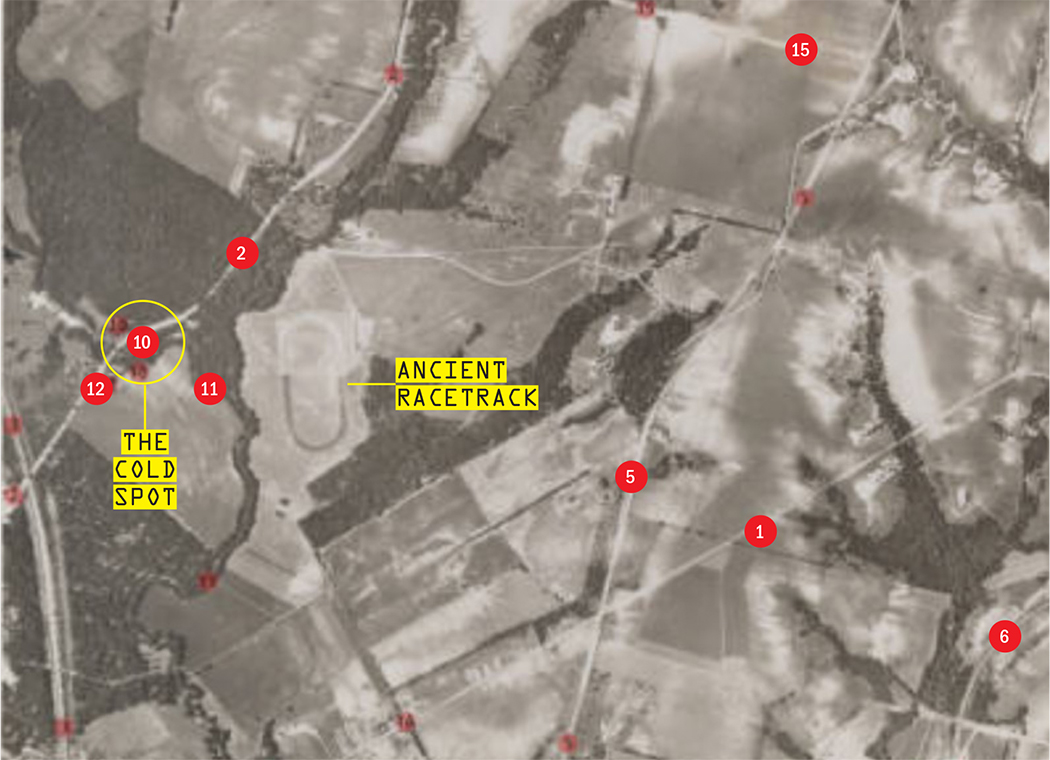
1. Part of Miller Road (renamed Fair Oaks)
2. Greenville Avenue/Richardson Road
5. Abrams Road
10. ‘The Cold Spot’ (area on Greenville Avenue with 10-degree average lower temperature than the surrounding area)
11. White Rock Creek
12. Deuback Skating Rink
Not mentioned is the visible outline of a horse racing track. Omitted numbers are due to cropping of the original image.
Aerial image of the northern White Rock Creek Area, created in the 1930s or 40s by Lloyd M. Long, provided by the Edwin J. Foscue Map Library, Southern Methodist University.
There is evidence that a microclimate — which might be explained by meteorology or the mystical, depending on your proclivities — has existed, maybe still does, near White Rock Creek in Lake Highlands.
In our search for historical images to support this month’s cover story, we came across a labeled aerial of the north White Rock Creek area, taken in the 1930s or ‘40s. One in a collection of 41 miscellaneous aerial photographs of Dallas, created by photographer Lloyd M. Long, it’s stored at a Southern Methodist University library. On the photo we located what we were looking for — evidence of an ancient racetrack on the Harry S. Moss Park land (see p. 25).
But that was not the only captivating item on the image — the key shows a little area that traverses Greenville, south of (what is now) Royal Lane, identified as “The Cold Spot.”
In parenthesis, the legend notes, “Area on Greenville Avenue near White Rock Creek with 10 degree average lower temperature than the surrounding area.” The notation left more questions than answers. We asked our city archivist (more on him on p. 12), two local meteorologists and a climate studies professor at a nearby university if they knew anything about it. Among those who called us back, none had an answer, for the record.
Native prairie and nature experts Mark Bulloch and Roger “Plant Man” Sanderson, go-to sources for past Harry S. Moss Park articles who grew up in the area, say they vaguely recall an “eerie” part of the grounds that frequently was especially foggy and, now that you mention it, chilly.
According to various published papers and articles, a cold spot is what scientists call a “microclimate.” As small as a rooftop garden or large as a city subdivision, a microclimate differs by at least 10 degrees from bordering areas. Woodlands can be cooler and less windy than surrounding grassland, therefore have the potential to produce microclimates. Certain soil conditions also can affect the air temperature. Other meteorological explanations (coastal causes, high elevation) do not apply in this case.
There is another possible explanation. In his book, “Paranormal Chronicles,” Neal Clark writes, “In paranormal research the prevailing theory is that when an entity is trying to manifest itself, it draws on many sources of energy. One of those sources is the heat energy in the air. As the entity draws the heat out of the air, the area in that specific location becomes cold, at least 10 degrees lower than the surrounding area.”





